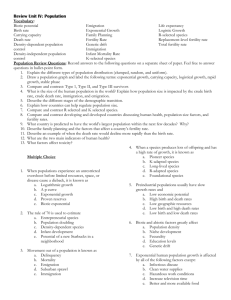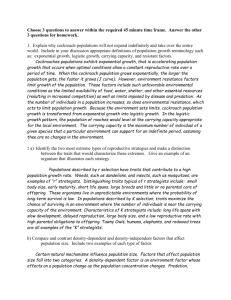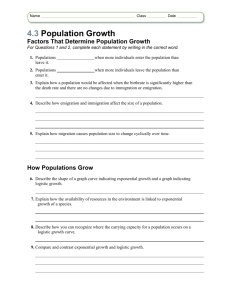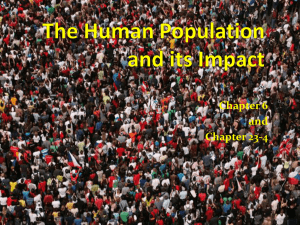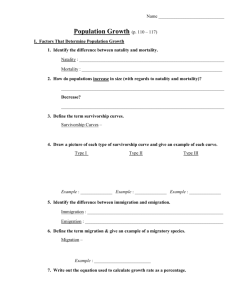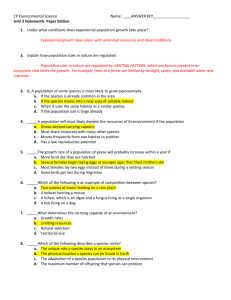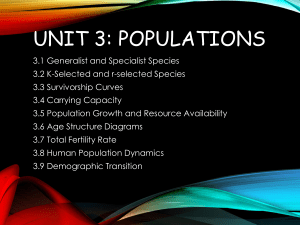Population Ecology
advertisement
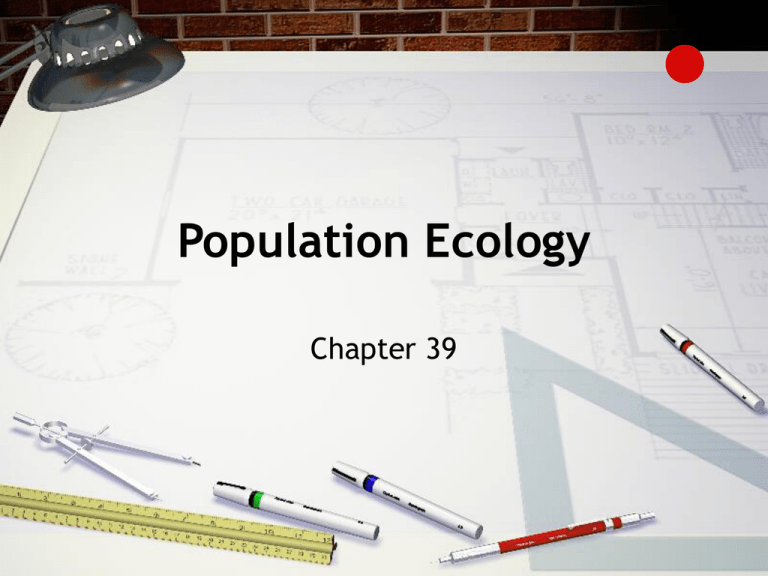
Population Ecology Chapter 39 Ecology - Definition • The science of the relationships between organisms and their environments. or • The interactions that organisms have with other organisms and with their environment. Population • A group of individuals of the same species occupying a given area • Can be described by demographics – Vital statistics such as size, density, distribution, and age structure Population Age Structure • Divide population into age categories – Pre-reproductive – Reproductive – Post-reproductive • Population’s reproductive base includes members of the reproductive and prereproductive age categories Density & Distribution • Number of individuals in some specified area of habitat • Crude density information is more useful if combined with distribution data clumped nearly uniform random Determining Population Size • Direct counts are most accurate but seldom feasible • Can sample an area, then extrapolate • Capture-recapture method is used for mobile species Capture-Recapture Method • Capture, mark, and release individuals • Return later and capture second sample • Count the number of marked individuals and use this to estimate total population Assumptions in Capture-Recapture • Marking has no effect on mortality • Marking has no effect on likelihood to being captured • There is no immigration or emigration between sampling times Changes in Population Size • Immigration adds individuals • Emigration subtracts individuals • Births add individuals • Deaths subtract individuals Zero Population Growth • Interval in which number of births is balanced by number of deaths • Assume no change as a result of migration • Population size remains Exponential Growth • Population size expands by ever increasing increments during successive intervals • The larger the population gets, the more individuals there are to reproduce Biotic Potential • Maximum rate of increase per individual under ideal conditions • Varies between species • In nature, biotic potential is rarely reached Biotic Potential • Which has greater biotic potential, • Elephants or frogs? • Elephants or rhinos? • Indian Elephant or African Elephant? Limiting Factors • Any essential resource that is in short supply • All limiting factors acting on a population dictate sustainable population size Carrying Capacity (K) • Maximum number of individuals that can be sustained in a particular habitat • Logistic growth occurs when population size is limited by carrying capacity Logistic Growth • As size of the population increases, rate of reproduction decreases • When the population reaches carrying capacity, population growth ceases Density-Dependent Controls • Logistic growth equation deals with density-dependent controls • Limiting factors become more intense as population size increases • Disease, competition, parasites, toxic effects of waste products Density-Independent Controls • Factors unaffected by population density • Natural disasters or climate changes affect large and small populations alike Human Population Growth • Population now exceeds 6 billion • Rates of increase vary among countries • Average annual increase is 1.26 percent • Population continues to increase exponentially Side-Stepping Controls • Expanded into new habitats • Agriculture increased carrying capacity; use of fossil fuels aided increase • Hygiene and medicine lessened effects of density-dependent controls Future Growth • Exponential growth cannot continue forever • Breakthroughs in technology may further increase carrying capacity • Eventually, density-dependent factors will slow growth Population Growth Curve Estimated size by 10,000 years ago 5 million By 1804 1 billion By 1927 2 billion By 1960 3 billion By 1974 4 billion By 1987 5 billion By 1999 6 billion Projected for 2050 8.9 billion Human Population Growth Fertility Rates • Total fertility rate (TFR) is average number of children born to a woman • Highest in developing countries, lowest in developed countries Fertility Rates Compared U.S. – brown bar Brazil – red bar Nigeria – gold bar Age Structure Diagrams • Show age distribution of a population Age Structure Diagrams: 1997 Population Momentum • Lowering fertility rates cannot immediately slow population growth rate • Why? There are already many future parents alive • If every couple had just two children, population would still keep growing for another 60 years Slowing Growth in China • World’s most extensive family planning program • Government rewards small family size, penalizes larger families, provides free birth control, abortion, sterilization • Since 1972, TFR down to 1.8 from 5.7 Effects of Economic Development • Total fertility rates (TFRs) are highest in developing countries, lowest in developed countries • When individuals are economically secure, they are under less pressure to have large families Demographic Transition Model • Based on historical data from western Europe • Postulates that as countries become industrialized, first death rates drop, then birth rates drop Demographic Transition Model Stage 1 Preindustrial Stage 2 Transitional Stage 3 Industrial Stage 4 Postindustrial relative population size births deaths low increasing very high decreasing low zero negative Immigration 1907 1914 new laws restrict immigration Great Depression Resource Consumption • United States has 4.6 percent of the world’s population • Americans have a disproportionately large effect on the world’s resources • Per capita, Americans consume more resources and create more pollution than citizens of less developed nations, or any other country by far! Projecting Human Population Size

